高分子材料在其加工或使用过程中,受到化学侵蚀、碰撞挤压等外部环境的影响,不可避免地会在内部产生微裂纹。这种微裂纹的出现会影响高分子材料的性能及使用寿命[1-2]。因此,针对高分子材料的自修复研究显得尤为重要。高分子的自修复类型包括外援型自修复与本征型自修复2种。外援型自修复过程依赖载体,当裂纹形成时,盛装修复剂的载体被打破,修复剂释放,自修复过程发生。本征型自修复无需额外的修复剂,由断裂面间的物理或化学作用驱动实现自修复,以其可自修复、可重塑等优势被广泛研究[3-5]。本征型自修复中,共价键连接(如亚胺键、二硫键等[6-9])比非共价键连接的作用力更强,因此被广泛应用于热可逆自修复体系的研究中[10-12]。
Diels-Alder反应是一种十分重要的热可逆共价化合反应[13],无需添加催化剂,条件温和,副反应少,具有很强的可设计性[14],目前已被应用于环氧树脂、热塑弹性体等高分子材料的制备中[15-17]。聚醚胺是一类含有聚醚骨架,以氨基封端的化合物。在之前的研究中,印杰课题组通过选用不同种类的胺单体和环氧单体进行开环反应,合成了一系列具有多重刺激响应性的聚醚胺,应用于纳米粒子的合成、染料分离等领域[18-21]。本文首先使用不同比例的呋喃甲胺(FMA)、聚乙二醇二缩水甘油醚(PEG-DE)和乙二醇二缩水甘油醚(EG-DE)进行预聚反应,合成了3种线性聚合物(Pre-PEA)。然后采用交联剂双马来酰亚胺(BMI)使Pre-PEA进行交联,制备了3个系列的交联聚醚胺(PEA)。测试结果表明,通过Diels-Alder反应制得的PEA样品具有良好的自修复和重塑回收性能,是一种性能优异、环境友好的高分子材料。
1 实验部分 1.1 主要试剂FMA:Alfa Aesar;PEG-DE:Sigmae Aldrich;EG-DE、BMI:TCI;无水乙醇:分析纯,中国国药集团。以上试剂均为分析级,未经纯化,直接使用。
1.2 PEA的制备按照表 1的投料比将一定量的PEG-DE,EG-DE和FMA溶于50 mL无水乙醇中,搅拌加热至60 ℃,反应8 h,减压蒸馏得到Pre-PEA,过程如图 1所示。从EG-DE与PEG-DE等物质的量之比投料的Pre-PEA的1H-NMR谱图可知,呋喃环上的质子峰于化学位移6.37, 6.26, 7.56处出现,4.54处出现了与呋喃环相连碳原子的信号峰,在3.72~4.31处出现聚醚胺线性结构部分的质子峰,表明预聚反应成功发生。
|
|
表 1 合成PEA的投料比 |

|
图 1 PEA的制备过程 Fig. 1 Preparation process of PEA |
将交联剂BMI和上述Pre-PEA以表 1中的配比溶解于无水乙醇中,在80 ℃的鼓风烘箱中干燥12 h,制得PEA,反应过程如图 1所示。
1.3 表征与测试使用Varian Mercury Plus 400 MHz核磁共振仪,溶剂为CDCl3,测定预聚物的1H-NMR谱图;在Perkin-Elmer 1000型傅里叶变换红外光谱仪(FT-IR)上进行测试,样品为溴化钾粉末压片。使用Instron4465型拉力机,测试条件25 ℃,相对湿度为30%,拉伸速率100 mm/min,样条为哑铃形,有效宽度为4 mm,有效长度为16 mm,每个样品平行测试5个样条。
自修复测试:用手术刀在PEA膜表面划出深度为0.5 mm的划痕,从室温20 ℃开始以10 ℃/min的速率升温,使用光学显微镜观测PEA样品的自修复过程,记录划痕开始愈合到完全愈合的温度范围。
溶胀性能测试:室温25 ℃下,称取质量为m1的PEA膜浸泡于DMF中,48 h后取出,吸干表面后称重,质量记为m2。放入80 ℃烘箱中干燥至恒重,质量记为m3,PEA样品的凝胶含量(GF)和溶胀比(SR)可根据以下公式计算得出。
| $ {G_{\rm{F}}} = \frac{{{m_3}}}{{{m_1}}} \times 100\% ;\;\;\;{S_{\rm{R}}} = \frac{{{m_2}}}{{{m_3}}} $ |
重塑性能测试:取PEA膜5 g,剪碎后分别采用以下2种方法重塑,重塑过程进行2次。(1)热压重塑:将剪碎的膜样品放置于平板模压机中,在10 MPa,160 ℃条件下热压5 min。(2)超声重塑:将剪碎的膜样品溶于DMF中,超声2 h后放入80 ℃的烘箱干燥12 h。测定重塑样品的应力-应变曲线。
2 结果与讨论 2.1 PEA的红外光谱分析图 2是Pre-PEA1-1与PEA1-1-100的红外谱图。由图 2可知,Pre-PEA1-1在1 142 cm-1处出现了呋喃环的特征吸收峰。PEA1-1-100在1 712 cm-1处出现了较为明显的羰基特征吸收峰,在1 187 cm-1处出现新键的特征吸收峰,1 142 cm-1处无呋喃环特征吸收峰,这说明Diels-Alder反应成功发生。
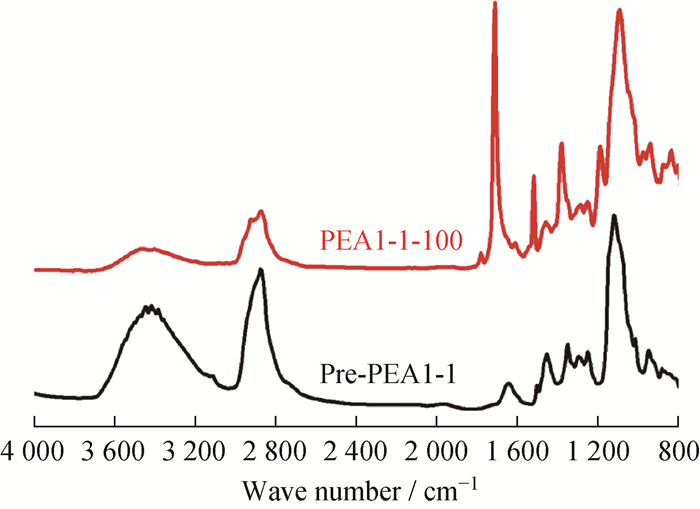
|
图 2 Pre-PEA1-1和PEA1-1-100的FT-IR谱图 Fig. 2 FT-IR spectra of Pre-PEA1-1 and PEA1-1-100 |
2.2 PEA膜的溶胀性能分析
PEA膜的溶胀性能分析如图 3所示。由图 3可知,随着BMI质量分数的增加,PEA膜的凝胶含量增加,溶胀比降低。实验结果表明,随着PEA样品中EG-DE与PEG-DE物质的量之比减小,PEA膜的溶胀比增加。这是因为,链段结构中氧元素含量越多,链段与极性溶剂分子间的作用力越强,溶剂分子越容易进入到交联网络中。
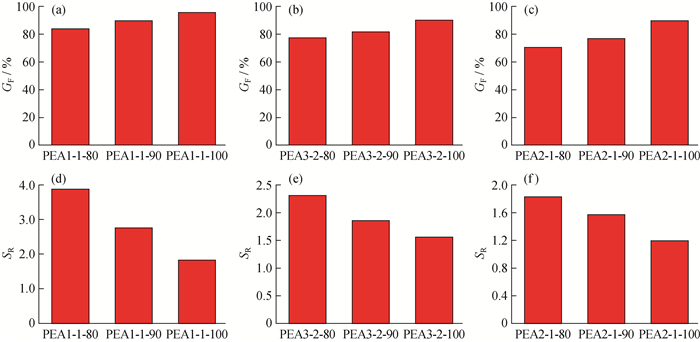
|
图 3 PEA膜的凝胶含量(a, b, c)和溶胀比(d, e, f) Fig. 3 Gel fractions (a, b and c) and swelling ratios (d, e and f) of the PEA membranes |
2.3 PEA膜的力学性能分析
本文进一步探究了交联度和分子结构这两种因素对PEA膜力学性能的影响。图 4为PEA膜的应力-应变曲线。

|
图 4 PEA膜的应力-应变曲线 Fig. 4 Stress-strain curves PEA membranes |
由图 4可知,提高BMI质量分数或增加PEA中EG-DE与PEG-DE物质的量之比均能增强PEA样品的断裂强度,降低断裂伸长率。随着BMI质量分数的增加,样品的交联度增加,聚合物内的作用力变强,断裂强度随之增加,断裂伸长率减小。增加EG-DE与PEG-DE物质的量之比,高分子主链中的氧元素含量随之降低,高分子链段的移动自由度减弱,结构刚性增强,利于分散荷载。但值得注意的是,样品PEA2-1-100的断裂强度低于PEA3-2-100的。这是因为,交联网络刚性过强会抑制高分子链的运动,使材料变得硬而脆,导致样品的断裂强度降低。
综上所述,PEA1-1系列样品膜比较柔软,具有典型的“柔性材料”特征,PEA2-1系列样品具有“塑性材料”的特质。在PEA3-2系列中,随着交联度的增加,样品性质展现了从“柔性材料”到“塑性材料”的转变过程。从图 4不同PEA膜的拉伸曲线能够观察到PEA膜从“软而韧”到“强而韧”的性质转变。
2.4 PEA的自修复性能分析Diel-Alder反应是一种温度可逆的反应,本文通过变温红外跟踪其反应进程。将温度从30 ℃升至150 ℃再降至30 ℃,对样品PEA1-1-100进行变温红外测试,结果如图 5所示。升温过程中,1 142 cm-1处呋喃环的特征吸收峰逐渐增强,1 187 cm-1处新键的伸缩振动吸收峰逐渐减弱,证明升温过程反应向逆反应方向进行。降温过程中,两峰的变化过程与升温过程相反,这证明了降温过程反应向正反应方向进行。结果表明,PEA中的交联网络是由热可逆共价键连接而成的,这是PEA膜的自修复及重塑功能的基础。
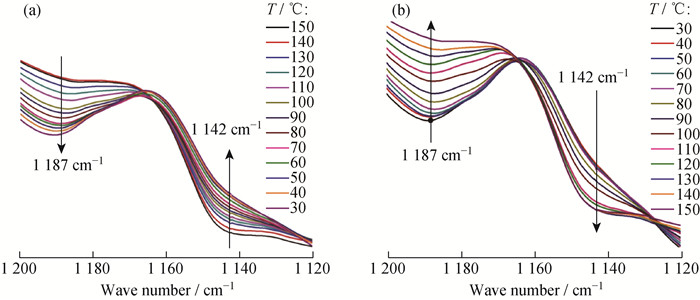
|
图 5 升温过程(a)和降温过程(b)中PEA1-1-100的变温红外谱图 Fig. 5 Variable FT-IR spectra of PEA1-1-100 during the heating process (a) and the cooling process (b) |
图 6为样品PEA3-2-80膜分别于40 ℃(自修复前)和110 ℃(自修复后)的划痕照片。从光学显微镜中观察到,升温至90 ℃时,PEA3-2-80膜表面的裂痕开始愈合,其初始愈合温度为90 ℃。升温至101.2 ℃时,表面裂痕恰好完全愈合,其完全愈合温度为101.2 ℃。9种PEA样品的初始愈合温度与完全愈合温度列于表 2中。

|
图 6 表面有划痕的PEA3-2-80膜在40 ℃(左)和110 ℃(右)下的光学照片 Fig. 6 Images for healing process of PEA3-2-80 membrane with a crack at 40 ℃ (left) and at 110 ℃ (right) |
|
|
表 2 PEA膜的自修复温度 Table 2 Self-healing temperatures of PEA membranes |
分析表 2可知,增加BMI添加量或EG-DE与PEG-DE物质的量之比均能提高PEA的自修复温度。从交联网络中链段运动的角度来说,当温度升高时,反应朝着逆反应的方向进行。此时,划痕附近链段的反应位点从交联网络中释放出来,与划痕破损处的反应位点结合形成新的可逆共价键,完成自修复。在此过程中,聚合物分子链的移动起到了重要作用,链移动能力越强,自修复反应就越容易发生。当PEA的交联度上升或者PEA主链柔顺性降低时,链移动能力减弱,交联网络的流动性就会变差,体系需要更高的温度获得更高的能量来实现自修复。
2.5 PEA膜的重塑性能分析将PEA2-1-80膜进行热压重塑,样品PEA2-1-100进行超声重塑来探讨PEA膜的重塑性能,重塑过程如图 7(a,b)所示。重塑产物分别进行2次重塑,应力-应变曲线如图 8(a,b)所示。结果表明,2次重塑后的样品断裂强度保持为原始样品的70%,断裂伸长率保持为原始样品的80%,证明本文合成的PEA具有良好的重塑成型性能。
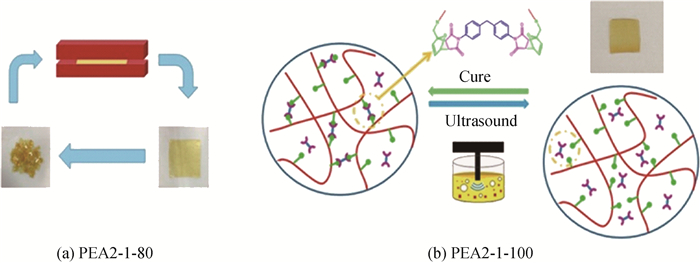
|
图 7 热压重塑(a)与超声重塑(b)的过程示意图 Fig. 7 Process schematic diagram of the heat press remolding method (a) and ultrasound remolding method (b) |
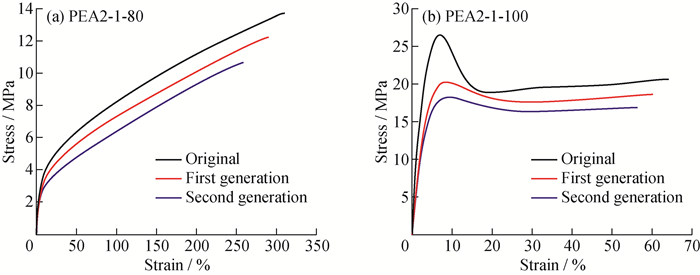
|
图 8 重塑成型后PEA的应力-应变曲线 Fig. 8 Stress-strain curves of the remolding PEA |
3 结论
本文合成了分子链上含有呋喃基团的聚醚胺预聚物,采用Diels-Alder反应,以BMI交联该聚醚胺预聚物,制得了PEA。通过对分子链结构的设计及交联度的调节,PEA的性能完成了从“软而韧”到“强而韧”的转变。Diels-Alder反应的热可逆性赋予了PEA自修复性能和重塑利用性能,其表面裂痕可以在120 ℃以下完全自修复。PEA能够通过超声与热压2种重塑方法进行重塑回收,2次重塑后的PEA膜,其断裂强度至少能达到原始样品的70%,断裂伸长率至少能达到原始样品的80%。
| [1] | MAULDIN T, KESSLER M. Self-healing polymers and composites[J]. International Material Review, 2010, 55: 317–346. DOI:10.1179/095066010X12646898728408 |
| [2] | DONG Yangwu, MEURE S, SOLOMON D. Self-healing polymeric materials:A review of recent developments[J]. Progress in Polymer Science, 2008, 33(5): 479–522. DOI:10.1016/j.progpolymsci.2008.02.001 |
| [3] | LIU Yingling, CHUO Tsaiwei. Self-healing polymers based on thermally reversible Diels-Alder chemistry[J]. Polymer Chemistry, 2013, 4: 2194–2205. DOI:10.1039/c2py20957h |
| [4] | SANYAL A. Diels-Alder cycloaddition-cycloreversion:A powerful combo in materials design[J]. Macromolecular Chemistry and Physics, 2010, 211(13): 1417–1425. DOI:10.1002/macp.v211:13 |
| [5] | KESSLER M. Self-healing:A new paradigm in materials design[J]. Proceedings of the Institution of Mechanical Engineers, 2007, 221(4): 479–495. DOI:10.1243/09544100JAERO172 |
| [6] | CANADELL J, GOOSSENS H, KLUMPERMAN B. Self-healing materials based on disulfide links[J]. Macromolecules, 2011, 44(8): 2536–2541. DOI:10.1021/ma2001492 |
| [7] | 杨广杰, 潘李李, 李晓娟, 等. 基于可逆动态共价化学的新型可修复、可回收、可加工环氧树脂[J]. 功能高分子学报, 2017, 30(2): 215–220. |
| [8] | ZHAO Wei, JIAN Haiyang, ZHEN Qiliu, et al. Self-healing materials:Novel biocompatible polysaccharide-based self-healing hydrogel[J]. Advanced Functional Materials, 2015, 25: 1352–1359. DOI:10.1002/adfm.v25.9 |
| [9] | DENG Guohua, TANG Chuanmei, LI Fuya, et al. Covalent cross-linked polymer gels with reversible sol-gel transition and self-healing properties[J]. Macromolecules, 2010, 43(3): 1191–1194. DOI:10.1021/ma9022197 |
| [10] | LEI Zhouqiao, XIE Pu, RONG Minzhi, et al. Catalyst-free dynamic exchange of aromatic Schiff base bonds and its application to self-healing and remolding of crosslinked polymers[J]. Jounal of Material Chemistry A, 2015, 3(39): 19662–19668. DOI:10.1039/C5TA05788D |
| [11] | WEI Zhao, YANG Jianhai, LIU Zhenqi, et al. Novel biocompatible polysaccharide-based self-healing hydrogel[J]. Advanced Functional Materials, 2015, 25(9): 1352–1359. DOI:10.1002/adfm.v25.9 |
| [12] | YU Shen, ZHANG Rongchun, WU Qiang, et al. Bio-inspired high-performance and recyclable cross-linked polymers[J]. Advanced Materials, 2013, 25: 4912–4917. DOI:10.1002/adma.201301513 |
| [13] | NICOLAOU K C, SNYDER S A, MONTAGNON T, et al. The Diels-Alder reaction in total synthesis[J]. Angewandte Chemic International Edition, 2002, 41(10): 1668–1698. DOI:10.1002/(ISSN)1521-3773 |
| [14] | KAVITHA A A, SINGHA N K. "Click chemistry" in tailor-made polymethacrylates bearing reactive furfuryl functionality:A new class of self-healing polymeric material[J]. ACS Applied Materials and Interfaces, 2009, 1(7): 1427–1436. DOI:10.1021/am900124c |
| [15] | ZHANG Anqiang, YANG Lin, LIN Yaling, et al. Self-healing supramolecular elastomers based on the multi-hydrogen bonding of low-molecular polydimethylsiloxanes:Synthesis and characterization[J]. Journal of Applied Polymer Science, 2013, 129(5): 2435–2442. DOI:10.1002/app.38832 |
| [16] | CHEN Xaingxu, DAM M A, ONO K, et al. A thermally re-mendable cross-linked polymeric material[J]. Science, 2002, 295: 1698–1702. DOI:10.1126/science.1065879 |
| [17] | DU Pengfei, LIU Xuanxuan, ZHENG Zhen, et al. Synthesis and characterization of linear self-healing polyurethane based on thermally reversible Diels-Alder reaction[J]. RSC Advance, 2013, 3: 15475–15482. DOI:10.1039/c3ra42278j |
| [18] | REN Yanrong, JIANG Xuesong, YIN Jie. Poly(ethertert-amine):A novel family of multiresponsive polymer[J]. Journal of Polymer Science:Part A. Polymer Chemistry, 2009, 47(5): 1292–1297. DOI:10.1002/pola.v47:5 |
| [19] | YU Bin, JIANG Xuesong, YIN Jie. Multiresponsive square hybrid nanosheets of POSS-ended hyperbranched poly(ether amine) (hPEA)[J]. Macromolecules, 2012, 45: 7135–7142. DOI:10.1021/ma301371h |
| [20] | WANG Rui, JIANG Xuesong, DI Chunfneg, et al. Multistimuli responsive organosilica hybrid nanoparticles based on poly(ether amine)[J]. Macromolecules, 2010, 43: 10628–10635. DOI:10.1021/ma1021055 |
| [21] | 张赛, 史子兴, 印杰. 明胶-环氧聚醚胺交联膜的合成及其对重金属离子的吸附性能[J]. 功能高分子学报, 2016, 29(1): 29–35. |
 2018, Vol. 31
2018, Vol. 31


